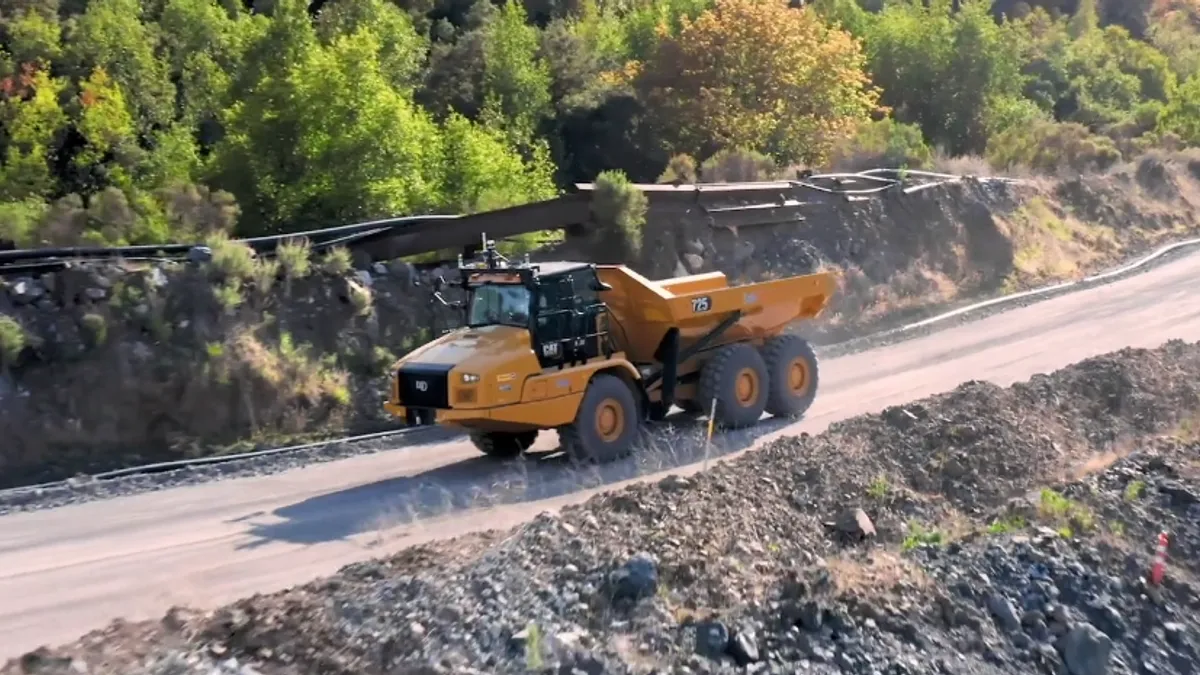Construction Dive’s Tech 101 series provides quick, top-line information about emerging construction technology on topics such as digital twins, 5G networks and exoskeletons. Click here for the entire series.
Like many emerging technologies in construction, the use of autonomous vehicles on jobsites today is still more of a rarity than a norm. But the technology is making inroads, both from original equipment manufacturers, and from the increasing use of retrofitted technology to make conventional vehicles drive themselves.
Contractors are taking notice of this emerging technology within the construction space. "We do believe that technology will fuel our innovation as a company," Tom Emison, vice president of strategy and innovation at Minneapolis-based construction management firm Kraus-Anderson, told Construction Dive. "As a result, we need to be aware of and embracing of emerging technologies as they become commercially viable for us."
What you should know
"Construction executives need to know that this emerging technology will make their job operations more safe, keep work on schedule and maintain efficiency, and will in most cases save on cost," said Ali Asmari, head of AI & machine learning at Hauppauge, New York-based ULC Techologies, which recently launched its automated Robotic Roadworks & Excavation System. "It’s important to note that using autonomous vehicles will not take away from jobs, but rather teach traditional workers a new skill that will benefit them as innovation continues to grow."
Construction equipment incumbents such as Caterpillar, Komatsu, Volvo, Hitachi and Liebherr already build machines that roll off the factory floor with automation built in. Caterpillar, for example, claims to have the world’s largest fleet of autonomous haul trucks, which have already transported 2 billion tons of mining material for its clients in that industry.
But startups including SafeAI and Built Robotics have also been busy developing tech that can convert existing vehicles into autonomous machines. The advantages there, says Bibhrajit Halder, SafeAI’s CEO, come down to cost.
“Your typical construction company already has hundreds and hundreds of existing pieces of equipment,” Halder said. “If they want to use them autonomously, retrofitting those existing assets absolutely makes sense.”
Beyond the machines themselves, other technologies are evolving in tandem with the autonomous equipment. Machine learning and guidance, telematics and remote control are among the technologies that are becoming available to the construction sector from an applications standpoint, and will play a key role in autonomous vehicles on construction sites.
Construction applications
Autonomous technology for construction promises safer working conditions, improved cost containment from optimized fuel consumption and operations and even the development of new job classes as operators leave the cab to pilot equipment remotely or engage in machine data analysis and refinement instead of conventional dirt and materials movement and construction.
"This is broader than just autonomous vehicles," said attorney Carol Sigmond, a partner in the construction practice group at law firm Greenspoon Marder. "The thinking should be about remote operation and observation, too. Fleets of dump trucks moving from jobsite to repository may be autonomous but someone will be monitoring them on computer. People will need to install, operate, debug and maintain these systems."
Basic autonomy is already a part of some existing construction equipment. Blade control on bulldozers using machine learning to consistently optimize the angle of attack, backhoes featuring return to dig automation and even rider comfort control (available for more than a decade) are examples of technology assuming repetitive tasks or otherwise increasing efficiency for operators, even if the machine isn't in full control.
Then, there are the efficiency advantages. Today’s data sets already include idle time, fuel consumption and maintenance tracking, and are likely to evolve toward greater automation as users dig deeper into the analytic opportunities available from machine data, and in turn use that data for improved machine learning.
Another advantage revolves around labor, a problem that’s only getting worse as today’s workers grow older.
"It is getting harder to find the guy that has 30 years of experience as a heavy equipment operator," said Jason Anetsberger, a senior product manager for Rolling Meadows, Illinois-based Komatsu America Corp. "It’s part of why the equipment is becoming more tech savvy. We’re trying to empower the operator with technology to make [them] and the machine that much more capable and productive in the end."
Roadblocks
Despite those advantages, adoption of autonomous technology for construction has been relatively slow compared to industries such as mining and agriculture. One reason why is because construction sites largely lack the more focused range of predictable, repetitive tasks over defined topographies that agriculture and mining enjoy. Rapidly changing jobsite conditions can hinder full-scale, driverless deployment of heavy equipment.
Tom Webb, vice president of strategic initiatives at Sugar Land, Texas-based heavy civil construction management software firm HCSS, said the variables of construction sites are simply different than other use cases.
"The nature of construction means what works in a lab environment just isn't enough," Webb said. "How many contractors have put a shovel in the ground and found something that they didn't expect in there?" Often, damaging something that's already in the ground can have major implications on a construction project, and machines may not know to stop if they hit something.
Cost has also been an issue, especially given the staggered upgrade schedules of many companies’ equipment fleets. But now, as retrofits to existing vehicles become more common, that hurdle may be coming down.
“The construction industry has been telling us they want to use autonomy, they want to connect the whole thing, but so far it has not been at a price point and maturity they can adopt,” SafeAI’s Halder said. “Now both the price point and maturity have improved to the point where you will see adoption accelerate.”
Notable projects
- A push toward improving operator safety industry-wide has led to the use of driverless crash trucks by on-road construction crews. Designed to act as a crash cushion between distracted drivers and an active work zone, crash trucks until recently required a live operator.
- Driverless technology developed by Fort Walton Beach, Florida-based Micro Systems was used in a pilot program with Coopersburg, Pennsylvania-based Royal Truck & Equipment. "Any time a driver can be removed from vehicles in a dangerous situation and there's nobody inside to receive damage or injuries is the measurement of success," said Royal Truck & Equipment president Rob Roy.
- The North Dakota Department of Transportation’s Autonomous Impact Protection Vehicle has also been used to protect construction crews from other drivers on the road who may not be paying attention to the construction site or have lost control of their vehicle. The technology, developed by Kratos Defense in partnership with Royal Truck & Equipment, converted a current NDDOT truck into a self-driving vehicle. The autonomous vehicle is monitored and controlled by a human-operated lead vehicle and will automatically follow behind construction equipment without putting a driver in danger.
- Converting existing vehicles is the same approach SafeAI took in a recent pilot with Japanese-based contractor Obayashi on a quarry site near Cupertino, California. The company outfitted a Caterpillar 725 articulated dump truck, demonstrating a vital function on the site: load-haul-dump cycles. Sensors and adapters in both the cab of the truck and outfitted to its external bumpers help the dump truck “see” and follow commands.
- Researchers from Baidu Research Robotics and the University of Maryland recently unveiled an autonomous excavator system (AES) that can perform material loading tasks nearly comparable to that of an experienced human operator while continuously operating for over 24 hours.
For more reading
Autonomous construction equipment is here
Built Robotics' massive construction excavator drives itself
How autonomous robots are changing construction
Caterpillar and autonomous mining
Construction and autonomous vehicles — Considerations for increased adoption























